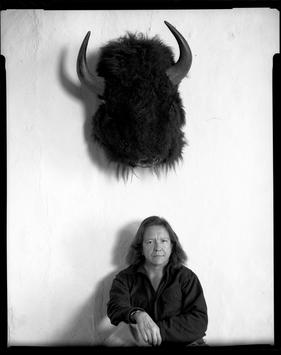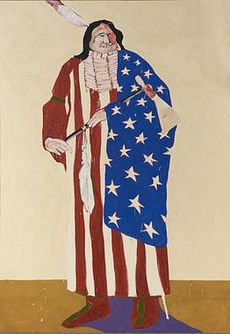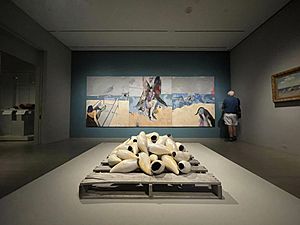Fritz Scholder facts for kids
Quick facts for kids
Fritz Scholder
|
|
|---|---|
 |
|
| Born | October 6, 1937 Breckenridge, Minnesota, U.S.
|
| Died | February 10, 2005 (aged 67) Scottsdale, Arizona, U.S.
|
| Nationality | Luiseño, United States |
| Movement | Abstract Expressionism |
Fritz William Scholder V (born October 6, 1937 – died February 10, 2005) was a famous Native American artist. He was a member of the La Jolla Band of Luiseño Indians, a tribe from California. Scholder's art was very modern and sometimes looked like Pop art. He wanted to change how people thought about Native Americans. In the late 1960s, he taught at the Institute of American Indian Arts in Santa Fe. He inspired many young Native American artists.
Contents
Early Life and Art Training
Fritz Scholder was born on October 6, 1937, in Breckenridge, Minnesota. When he was in high school in Pierre, South Dakota, his art teacher was Oscar Howe. Howe was a well-known Yankton Dakota artist. In the summer of 1955, Scholder went to an art camp at the University of Kansas. He learned from a teacher named Robert B. Green.
In 1956, Scholder finished high school in Ashland, Wisconsin. He then spent his first year of college at Wisconsin State University in Superior, Wisconsin. There, he studied art with Arthur Kruk, James Grittner, and Michael Gorski.
Beginning His Art Career
In 1957, Scholder and his family moved to Sacramento, California. He continued his art studies with a teacher named Wayne Thiebaud. Thiebaud asked Scholder to help open a new art gallery in Sacramento. Scholder's first art show there got great reviews.
His next solo art show was at the Crocker Art Museum in Sacramento. His artwork was shown in many places, including the California Palace of the Legion of Honor in San Francisco. After graduating from California State University, Sacramento, Scholder was invited to a special art project. This project was for Native American art at the University of Arizona in 1961.
The "Native Americans" Art Series
While at the University of Arizona, Scholder met Cherokee designer Lloyd Kiva New. He also studied with Hopi jeweler Charles Loloma. After getting a special art scholarship, Scholder moved to Tucson. He became a helper in the Fine Arts Department. He studied with Andrew Rush and Charles Littler. He also met artists Max Cole, John Heric, and Bruce McGrew.
After earning his master's degree in 1964, Scholder became an art teacher. He taught painting and art history at the new Institute of American Indian Arts in Santa Fe, New Mexico.
Scholder often created art in "series" or groups of paintings. In 1967, he started a new series about Native Americans. These paintings showed a "real Indian" and caused a lot of discussion. Scholder painted Native Americans with American flags, beer cans, and cats. He wanted to challenge old ideas and stereotypes about Native Americans. His paintings showed the difficulties of Native American life in the 20th century. They often used humor to point out strange situations. Scholder did not grow up on a reservation, so his view was unique.
Scholder left the IAIA in 1969 and traveled to Europe and North Africa. He then returned to Santa Fe and set up a studio.
In 1970, he was invited to the Tamarind Institute in Albuquerque, New Mexico. There, he created a group of seven lithographs called Indians Forever. This series showed his ideas about modern Native Americans. It also helped the Tamarind Institute become a top printmaking center. The first book about Scholder's art, Scholder/Indians, was published that same year. Scholder also had his first solo show at the Lee Nordness Galleries.
He became a major influence for many Native American artists. He gave talks at many art conferences and universities. These included Princeton and Dartmouth. In 1972, an exhibition of his Dartmouth Portraits opened in New York. It received good reviews. That same year, the Smithsonian American Art Museum suggested a show featuring Scholder and one of his former students. Scholder chose T. C. Cannon. The show opened in Washington, D.C. and traveled to other countries. In 1974, Scholder had a solo show at an art fair in Switzerland. After that, he traveled to Egypt and painted the sphinx and pyramids.
In 1975, Scholder made his first etchings in California. His work was featured in a Public Broadcasting System TV series about Native American artists. Other artists in the series included R. C. Gorman and Helen Hardin. Also in 1975, a book of his lithographs was published. Scholder started making monotypes in 1977. His first photo exhibition was at the Heard Museum in 1978. A book of his poems was published in 1979. In 1980, Scholder was a guest artist at the Oklahoma Art Institute. This led to a PBS film called American Portrait.
Awards and Recognition in the 1980s
In 1981, the Tucson Museum of Art held a special show of Scholder's art. He was asked to choose which artworks to display. In 1982, Scholder bought an apartment in Manhattan. A big book about his art was published. Scholder also returned to Egypt at the invitation of a famous archeologist.
In 1983, Scholder received a New Mexico Governor's Award for Excellence in the Arts. He became a lifetime member of the Salon d'Automne and showed his art in Paris in 1984. The next year, he received the Golden Plate Award. In 1991, a book called Afternoon Nap was published. Scholder received five honorary degrees from different colleges and universities. He also received a humanitarian award.
Later Art Exhibitions
In 1994, artist Leonard Baskin asked Scholder to work on a major book project. Scholder returned to Arizona and started his own printing press. He then spent time at the MacDowell Colony in New Hampshire. The next year, two big shows opened. These were The Private Work of Fritz Scholder at the Phoenix Art Museum and Fritz Scholder/Icons and Apparitions in Scottsdale. Scholder began his Millenium series and worked in London, Paris, and Budapest.
In 1999, Scholder finished Future Clone. This was an eight-foot-tall bronze sculpture. It was described as an "androgynous angel figure." In 2000, he created his first digital book, Thoughts at Night. That year, Scholder returned to Santa Fe for an exhibition called Alone/Not Alone. In October 2001, a major show about death and skulls opened. It was called Last Portraits and was at the Tweed Museum of Art in Duluth. In March 2002, a show called Orchids and Other Flowers opened. This was Scholder's artistic response to 9/11. Scholder received the 2002 Arizona Governor's Award.
Honors After His Death
On August 25, 2009, Governor Schwarzenegger announced that Scholder would be inducted into the California Hall of Fame. His art was then shown at The California Museum. The induction ceremony was on December 1, 2009. Scholder's Future Clone sculpture was even shown in the 2010 movie Black Swan.
On November 1, 2008, the National Museum of the American Indian opened a big show of Scholder's art. It was called Indian/Not Indian and was in Washington, DC, and New York. On October 4, 2015, the Denver Art Museum opened a traveling exhibition. It was called Super Indian: Fritz Scholder, 1967–1980. This show then traveled to the Phoenix Art Museum and the Nerman Museum of Contemporary Art.
Scholder's art was also part of Stretching the Canvas: Eight Decades of Native Painting. This show was at the National Museum of the American Indian George Gustav Heye Center in New York.
In June 2022, Scholder's important painting, "Possession on the Beach," was shown. It was displayed in the American Wing at The Metropolitan Museum of Art in New York City.



